Like yesterday, I included goldfish crackers in a lunch picture. And I’m like, how long is it going to take before someone yells at me about the goldfish?
You’re listening to Burnt Toast! This is the podcast where we talk about diet culture, fatphobia, parenting, and health.
Today I am chatting with fan favorite, and my best friend, Amy Palanjian. Amy is the creator of the blog Yummy Toddler Food, and she’s on Instagram and Tiktok, as we’ll talk about. She’s also my former podcast co-host of the Comfort Food podcast, and a frequent flyer here on Burnt Toast.
Today we’re talking about the business of kid food blogging, and the line Amy walks in trying to present realistic relatable content, but also have people be aware that this is a business and have that labor be somewhat visible. No one has ever asked Mark Bittman (or any other male food writer) if they are making a living writing recipes. We know and understand they run a business—but when women do this, and especially when moms do it, we act like it’s not work. We also get into broader themes about how we make domestic work visible and what happens when we do that.
If you enjoy this episode, please subscribe, rate and review us in your podcast player! It’s free and a great way to help more folks find the show.
For an upcoming bonus ep, I’m trying out a new format: Virginia’s Office Hours. If you have a question about navigating diet culture and anti-fat bias that you’d like to talk through with me, or if you just want to rant about a shitty diet with me, you can submit your question/topic here. I’ll pick one person to join me on the bonus episode so we can hash it out together.
Bonus episodes are for paid subscribers only, so join us here so you don’t miss out!
Virginia
This conversation is inspired by a piece you wrote for your newsletter a little while ago where you kind of… came out to your audience. You were like, “Guys, this is a business. I’m a blogger, recipe developer, influencer, cookbook author. This is a business.”
So I just want to start by saying it feels weird that you had to explain this to people. My first thought in reading it was: Does Mark Bittman have to explain to people that he runs a business? I don’t think so.
Amy
There’s this assumption maybe that the recipes that I share are like, a food diary. That I’m taking pictures of the food I’m making for my kids, and then just happening to share them. And I think that’s the way that blogging started many, many years ago. Blogs were sort of diaries. And there are a lot of people on social media now that are stille doing that. They don’t have fleshed out websites. They’re just sharing stuff on Instagram or Tiktok. I think the assumption is, Oh, she just happened to make this for her family and she’s sharing it with us. But most of the time when I’m cooking for work, my children are not even home.
I have a content calendar that is scheduled out many, many months ahead of time. I am doing almost nothing in real time. Because I can’t! There’s production time on shooting everything and writing all the content and doing all the videos. I have to be ahead of schedule, because that’s the way you run most businesses.
Virginia
You do run them with a plan. You don’t tend to just show up one day and be like, Hey, let’s make some stuff.
Amy
I think there are people that do that. But I run my website like we ran magazines. I have gotten a lot of requests like, “Can you show the ‘after’ plate?” Like, I’m not gonna sit there and videotape everything that my kids are eating, right? Because a that’s a giant pain. And it’s such a strange thing to do to a kid.
Virginia
It’s a real invasion of privacy to be like, “Okay, eat dinner, I’m just going to be here cataloging whether you like it and what you eat!”
Amy
And how much my kids eat has no bearing on how much your kids eat. It’s a strange request for information because it’s basically meaningless.
Virginia
They just either want some reassurance that your kid doesn’t eat it either. Or they want to feel bad because your kid eats something that their kid won’t eat. No good comes from these comparisons.
Amy
And my kids don’t eat everything that I make for the website. They are a sample size of three! I have enough food experience that I can taste a recipe and judge whether or not it’s good, from a much different lens than my children can.
Virginia
That’s another way I feel like the labor of all of this is made invisible. Because you are writing recipes for kids, there is an assumption that your children are the experts on your work. As opposed to understanding that you develop recipes because you have years of experience developing recipes, and you know what tastes good because this is your work. Again when any male food writer is like, here’s this amazing stew, we’re not like, But did your wife like it? Did your friends eat it? We trust them when they say this was amazing. I’m insulted on your behalf that people are like, Did Selway eat it? No offense, Selway, but it’s not really your job.
Amy
That would be the most maddening way to have my website.
Virginia
When your kid is going through the inevitable only eats mac and cheese for six months phase, what are you supposed to do for content? Just keep putting out mac and cheese recipes? It’s very strange.
When we’re consuming social media content, I think all of us need to understand the amount of work that goes into producing those images. And because they are images of domestic life, we assume that no work went into creating them. That feels really devaluing of your professional work and of domestic life.
Amy
Well, it’s also questions like, Why do you need daycare? You’re just cooking. Why can’t your kids just be home? There was a lot of that during COVID. Like, what’s the big deal? I mean. Have you ever tried to write anything with a toddler on your leg?
Virginia
The way your photos are so beautifully shot and you’re so carefully styling the plate—you can’t do that with kids underfoot.
Amy
I know some people who have Instagram accounts who do it with their kids at home. There’s one person in particular who, once a month, will send me emails about how she’s drowning, and she can’t do all the things. I’m like, But you have no childcare! You’re comparing your output to mine and I have full-time childcare, because I’ve chosen that and you haven’t.
[Virginia’s Note: Or maybe it’s not in the budget/unavailable for other reasons. But that’s all the more reason not to expect to do all the things. The system is failing you!]
You have to give yourself a break. It’s completely not fair for people who are trying to do it while they’re taking care of their kids to think that they should be able to do all of the things. It’s all very muddy.
Virginia
That’s an example of the way these myths get perpetuated on Instagram by both the creators of the content and the viewers of the content. I’m not surprised someone thinks they can get into this work without needing childcare, because that’s an image that gets sold. You are very transparent about having childcare, but that’s not everybody. There are plenty of influencers who aren’t thanking the nanny or the daycare center workers, and are letting you believe that it’s all happening with their kids in tow. That sets women up to fail.
Amy
Or you see someone on TikTok who’s making an income by posting videos dancing with their babies. And you’re like, well I should be able to do that—TikTok in particular has really changed what is possible because it pays people once you have a certain number of followers. But I still feel like the assumption that you should be able to do all the things is just really murky.
Virginia
Also, let’s not discount the amount of labor that goes into making those videos. Like what if the baby’s cranky and you need to make them dance? We’re supposed to watch the video and think that she just happened to catch this totally charming moment with her child, but she learned a dance routine, figured out how to do it with the music, and then edited it afterwards. It’s a lot of production.
Amy
So, for the most part, I try to let my kids eat without being videotaped, unless we’re gonna do something for a video and I tell them. But the other night, I was making dinner and my husband had the girls out of the house, so it was just the little guy and I. I had made some roasted carrots while the rest of dinner was cooking. And I honestly and truly do not know what made me start filming. There was nothing about me that was camera ready. I just was in whatever clothes I was wearing. My hair is kind of a mess. And I started filming it. So it actually was real. I put the carrots down and I asked Selway if he wanted them. And we went through this whole thing where he said I made the wrong carrots because I cut them into sticks versus circles. Then I just talked him through the carrot situation as I would in normal life. I compared the carrots to his crayons because they were sitting on the table. We got out some ketchup he wound up eating the whole thing of carrots. So I shared it on Instagram. It went like kind of nuts.
[Virginia Note: By “kind of nuts” Amy means that Selway eating carrots now has over 5.4 million views between Instagram and TikTok.]
As I was about to post it, I thought, okay, but now everyone’s going to think that my kids eat everything. Because this just happened to be a moment that went with this particular way. And I have not happened to catch a moment that went the other way. I do think the things I did along the way in that video do show the way I talk about food because I was not claiming that the carrots were gonna make him fly, I was not selling health messaging. It was like, “These are really yummy. These are mommy’s favorite. I’m gonna eat them all.” But there is this false promise when you see a kid eating something and you think, well my kids should eat that. And if they don’t, it’s either I’m failing or my kid is failing. I posted it and it immediately started doing really well and I’ve just been feeling so uncomfortable about it.
Virginia
Because you’re worried you were putting out that false expectation?
Amy
Right and I tried really hard to clarify that this doesn’t always happen in the caption. But anytime you videotape something, you are taking it out of context. It’s not what would be like if you didn’t have the phone on. And I think that’s the thing that we all forget. If you’re videotaping food, it is going to look different than if you didn’t videotape food, because you want the food to look a certain way. You’re going to choose something in the beginning that grabs people’s attention. You might put it in a different bowl or a cup that’s going to make people ask a question. You’re going do stuff to get people to engage in a way that you would not if you were just making yourself a bowl of oatmeal.
Virginia
Right. You wouldn’t be like, “I need to sprinkle something on top of the oatmeal because beige oatmeal doesn’t actually look good.” All of that is manufactured.
Amy
I think it’s really, really hard to remember, when you’re looking at videos of food, that there were lots of decisions made because people are going to be looking at it that are just a few steps away from “real.”
Virginia
I am curious to hear more about what motivated you to start filming. Does it feel hard to just be making dinner for your family and not thinking with one part of your brain, is there content here?
Amy
I go through periods that are better than others. I think it’s harder now because of the way that Instagram has changed in the past six months, where if you want to be growing, you have to be posting a lot of video. And so I can’t really turn that part of my brain off. To some extent, I am always like, “Is this something?”
We pretty much don’t tape anything at dinner. I try to do most of it during the day, but that is always on in my head. My phone’s usually nearby, so I can turn on the camera pretty quick. [Another time] Selway had gone to the freezer and was getting himself a popsicle completely on his own, so I videotaped that because I was like, well, I might use this.
I mean, it’s hard. I sort of hate it because it’s putting my kids in a position that they didn’t ask to be in. And, you know, they’re getting older. This is a temporary phase of their life. But the potential for the number of eyeballs to see my content has drastically changed and it makes me feel really differently now to think about sharing them. But I’m not quite to the place where I feel like I can stop because it does seem so integral to my brand. Like, I posted that carrot video on TikTok an hour ago. I do not have a lot of TikTok followers and 30,000 people have already seen it. [Virginia Note: By publication time, that number was over 700,000 on TikTok alone]
I also find it to be incredibly difficult to take days off because of the nature of how connected this all is to my business.
Virginia
Let’s talk about how these misunderstanding about the business of making food content plays into diet culture standards. I think those “What I Eat in a Day” videos are such a good example. I was thinking about a reel I saw Cassey Ho do—she’s Blogilates. So she’s a fitness influencer and a diet influencer, straight up. She had a reel where she started by showing a beautiful shot of her protein pancakes covered and blueberries with the syrup dripping down them. And the caption says “sometimes I eat like this.” And then the shot changes, and it’s her eating canned chicken, plain out of the can, and lettuce out of a bag of salad. And she’s like, “and some days, I eat like this.”
And her message with the video was that you don’t have to always be pulling off this beautifully produced meal. Like, she was trying to show that the pancakes are fake and manufactured. But in her case, well, when you strip away what makes that meal pretty, it turns out, she’s just eating canned chicken and lettuce because she’s living on a really restrictive diet. So it was very revealing in a way that I don’t think she intended because it shows that in a lot of this “What I Eat in a Day” content, we’re making food look pretty to make up for the fact that it’s not very filling or satisfying. Which is obviously very different from your recipes, which are delicious and not diet culture content.
Amy
Well, like take the assumption that all the food I’m making is the food that my kids are eating. The reality is that 99 percent of what my kids eat, nobody ever sees. I’m not like taking videos of them eating their goldfish for snack because, there’s nothing to see. It looks the same in my house as yours! But then people say, “I wish my kids ate like your kids eat.” And I’m like, “Well, I think they probably do.” Or, “I wish I was as good of a mom as you.” I’m like, “This is my job.”
Virginia
And why are we measuring people’s quality as a mom by the food they serve? It’s a little more than that. Not to reduce what you do! But, that isn’t your mom work. That’s your business. That’s not what you do as a mom.
Amy
I think in kid food, particularly, the thing where it intersects with diet culture is in the types of food that we’re deciding to show or the types of food that we now expect kids to eat. Like which type of crackers you use. Yesterday I included goldfish in a lunch picture and I’m like, How long is it gonna take before someone yells at me about the goldfish? It’s making those choices. There’s a lot of behind the scenes thinking that goes along with that, so I think you have try really hard to not be sending those messages.
Virginia
It’s hard too because you have to decide if you’re up for the goldfish fight, right? But if you don’t include the goldfish, then you’re upholding this standard you don’t agree with, even if it’s just inadvertently.
Amy
Here’s another example. I do a lot of content on storing produce or making your produce last longer or freezing things. I have six reusable stasher bags, like the fancy silicone ones that come in colors. I typically use those in videos, because they look nice. They are expensive, I’m not gonna lie. The big ones are like $30 apiece. I got them for free. And again, I have six of them. I do not have a whole stash of them. You literally see the same one in most posts. But a lot of people call me out for using something that’s expensive. And yet, if I showed a regular Ziploc bag, there would be a cascade of people complaining about the plastic. So, like, which is better?
Virginia
You can’t win.
Amy
Right, but I do think that showing the reusable fancy eco one is also perpetuating that feeling that you have to use this.
Virginia
And that your freezer should be pretty this way.
Amy
Or that this is the only safe option. I did have a whole DM conversation with someone where she was like, “I’m trying to switch to all glass and silicone for my freezer it because I need it to be safe for my baby.” And then I have to explain like which plastic is actually problematic, what not to put in plastic, and then all the ways you can use plastic. But, so many assumptions are being drawn from those visuals and that’s tricky.
Virginia
For the record, I cheer whenever you put goldfish in the lunch and share it whenever you put more than three M&M’s in something. Oh and I also loved your banana sushi reel. Let’s talk about that one.
Amy
Okay, so banana sushi is where you put peanut butter or another nut or seed butter on a tortilla, you put a banana in the middle, you roll it up and slice it, so they look sort of like spirals. They’re cute. So I made the thing and then I took one apart with my hands and smashed it all together, acting like I was a toddler. I was like, this is either gonna do really well or it’s gonna look really dumb. And it did really well. I think it’s helpful for people to see that I’m going to make this thing for my kid and they’re going to rip it to shreds and maybe eat it. Because kids are really tactile. I did not want to make that video and be like, this is an amazing toddler lunch and leave it at that. Because I know there is no way I could give that to any of my children and they would actually just put it in their mouth.
Virginia
Right, right. I’ve done peanut butter and jelly that way and then watched my children unravel it all and I’m like, “Why are you monsters?”
Amy
I know. Why didn’t I just make a regular sandwich?
Virginia
Why are you not appreciating the adorable aesthetic of the sandwich I’ve made you? Occasionally, it has delighted my children when I’ve made stuff in shapes. I do have some of those little Japanese sandwich cutters and my younger one went through a phase where she was enchanted. And then they started coming back not eaten in the lunchbox and I was like well, back to regular regular peanut butter and jelly for you, kid. I’m not going to any extra trouble here.
But it does seem really challenging to talk about that honestly with your audience, especially because I feel like influencers are under a lot of pressure to seem “authentic,” right? And often that version of authenticity is not authentic, right?
Amy
It’s manufactured.
Virginia
It’s often like, “Mama, I see you.” And showing the chaos without being like, “If we had a better society, this would not be so hard.” So then we’re continuing to perpetuate the expectation that motherhood is so hard and you’re crumbling all the time, without directing the anger that we should have about that towards the institutions responsible.
Amy
Yeah, I’m trying when I can, especially with voiceovers, to be more realistic. But you have to do it on purpose.
There’s someone that I follow, Sarah Crawford, her account is @bromabakery. So, she does all this baking. She makes a giant mess. And I’m like, at what point did she realize that that was her thing? Because I doubt if she didn’t have her camera on that she would be playing it up that much.
Virginia
Oh, interesting. Do you think she’s making it messier than it has to be?
Amy
I think she might be.
Virginia
Sarah, we want to know! DM us.
Amy
She is very good at social media. She has a whole program that she sells, she’s very good at it. And that’s the thing that she’s decided that she’s doing, which, like, kudos to her for figuring it out. But also, it’s maybe not real?
Virginia
God. It’s like, none of its real. It’s so fascinating. I think the takeaway for those of us who just consume this content is just keep the lack of reality in mind all the time. I don’t know what shifted. I was reading Real Simple magazine last night. And I know none of that is real, right? And maybe that’s because I worked in magazines and I saw what went into photoshoots. Maybe you didn’t know all the tricks that they use to make the food look perfect, but you certainly knew—well, maybe you don’t know. I do remember when we used to shoot lifestyle stories together, being shocked at the first photo shoot when it’s like, oh, wait, we’re not going to eat the food that you had all these people over to be at a party. We’re shooting a party at our house, but…
Amy
You’re not actually having a party and taking pictures.
Virginia
Right. It’s also totally manufactured thing. So maybe we didn’t even know about magazines and that’s why we don’t know about social. But I do think we even more don’t know it about social. We expect that we are seeing what people are really cooking to feed themselves and it creates these unrealistic standards for the viewers And it devalues the work of content creators, too.
Amy
I think it’s giving us completely unrealistic expectations for what we should be making and feeding our families.
Virginia
Like family dinner should look like a photoshoot every day?
Amy
Or you should have the baby who is like stuffing all the food into their mouths happily. There’s so much comparison that comes out of it that I think really is problematic. It’s hard to remember to run it through the filter of your own life.
Virginia
Agreed. Well, we also had a request from folks on Instagram to talk about maintaining mom friendships, which I think is a lovely topic. Amy and I have been best friends since.. How old were we? 22? 23?
Amy
I think we were 23.
Virginia
We were babies. Babies!
Amy
Maybe I was 23 and you were 22.
Virginia
So it’s almost 20 years of being friends. And the other thing about us is we lived in New York City together for five years and then the whole rest of our friendship has been long distance. You moved to Iowa. I moved to the Hudson Valley. Now you’re in Pennsylvania. So we’re still hours apart, and yet here we are. So how did we do it, Amy? How are we so great?
Amy
I think our texting is really the magic glue.
Virginia
It’s just texting.
Amy
I’ve got nothing besides that.
Virginia
Constant texting.
Amy
I mean, I think obviously it helped that we were working in the same industry. So we’re constantly talking about both work and life and we have a lot in common because of that. We’ve often been, I was gonna say freelance, but that seems like the wrong word, but like making your own businesses.
Virginia
I use freelance, for sure. You were an editor at magazines that kept folding. So it was a little different.
Amy
And then I learned how to be a freelancer for you.
Virginia
We were both figuring it out.
Amy
I think that had a lot to do with it. We did email a lot, before we started texting. We had these really amazing rainbow email threads.
Virginia
Yeah, that was a pre-kids thing. We couldn’t sustain that. We used to write long emails and we would respond in-line and we would change our font colors so you could keep track of the conversation. I hope our grandchildren discover those emails someday.
Amy
Those were amazing. That’s like how we planned our weddings.
Virginia
I was going to say baby showers. And then we switched to texting because it was just much more efficient. It also helps that we’re on similar sleep schedules. We’re both awake early in the morning. There’s you and maybe two other people that I can text at five in the morning and fully expect a response, and who won’t text me at 10pm because I will lose track of the text because I’m asleep. So, I think texting is the only answer. I don’t know how previous generations did it. But I do think, keep your mom friends close. They’re very important. Very key to our survival.
Butter for your Burnt Toast
Amy
So I recently finished Book Lovers by Emily Henry.
Virginia
Oh, that’s a good one!
Amy
It was delightful read I was very sad when it was over.
Virginia
My recommendation is also a book, but it’s nonfiction. It is our dear friend Kate Tellers' book How to Tell a Story. I figured this was a good episode to shout it out because Amy and I are both Kate superfans. So I’ll even link to our very old Comfort Food podcast episode where Kate came on and we talked about family dinner. Kate Tellers is one of our longtime friends, also from our New York City days. She works for The Moth, the storytelling organization, and they have an incredible new book out about how to tell a story. It is great if you are someone who wants to do oral storytelling. I also got a lot out of it in terms of thinking about writing. It’s just a great craft book. It helps you really understand why some people are great storytellers and some people, when they start to tell a story, you just die inside, because you know the anecdotes going to take so long. They guide you through the process. So, it’s wonderful.
I do think we have to agree that on an anecdotal level, Kate is the best storyteller I think we both know, hands down.
Amy
Yes. Sometimes in our text messages it’s very funny because she’ll just start halfway through the story and then we’re like, but wait…
Virginia
Kate, bring us in. We need a little backstory! Yes, she’s also on the group mom text chain and we are regularly brought into car trouble or various shenanigans. It’s great. But the book is excellent and she’s not the only author, there are five co-authors and they all do a really great job. So, I recommend that if you are interested in working on your writing game or your storytelling game or just want to learn more about how stories get made.
Thank you, Amy, for coming back. Always a delight to have you on Burnt Toast. I really appreciate it. Tell people where they can find you!
Amy
I’m at yummytoddlerfood.com or @Yummytoddlerfood on all the socials now.
Virginia
Amy
Yeah, that was a decision that I did not take lightly. But it is what it is now.
Virginia
I’m watching and dreading maybe having to join you. I’m still on the fence. I appreciate you blazing the trail for those of us who may or may not follow.
Amy
Yeah, I often just have to cover my eyes if I’m on there.
Virginia
Well, thank you for doing this. We really appreciate it.
Thanks so much for listening to Burnt Toast! Once again, if you’d like to support the show, please subscribe for free in your podcast player. Leave us a rating or review and tell a friend, maybe a mom friend, about this episode.
And consider a paid subscription to the Burnt Toast newsletter. It’s just $5 per month or $50 for the year. You get a ton of cool perks and you keep this an ad- and sponsor-free space.
The Burnt Toast Podcast is produced and hosted by me, Virginia Sole-Smith. You can follow me on Instagram or Twitter.
Burnt Toast transcripts and essays are edited and formatted by Corinne Fay, who runs @SellTradePlus, an Instagram account where you can buy and sell plus size clothing.
The Burnt Toast logo is by Deanna Lowe.
Our theme music is by Jeff Bailey and Chris Maxwell.
Tommy Harron is our audio engineer.
Thanks for listening and for supporting independent anti-diet journalism.



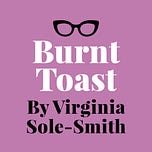

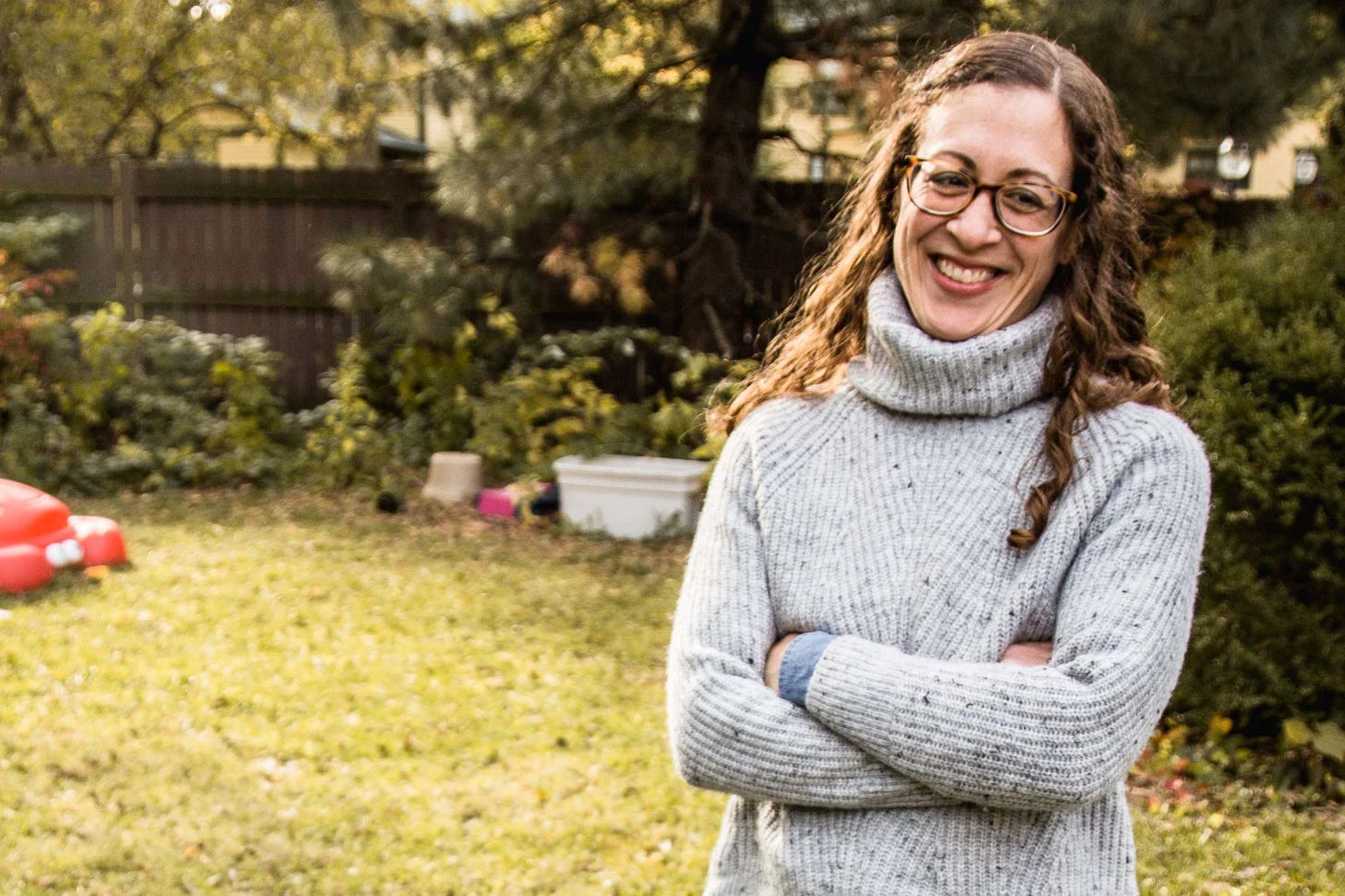
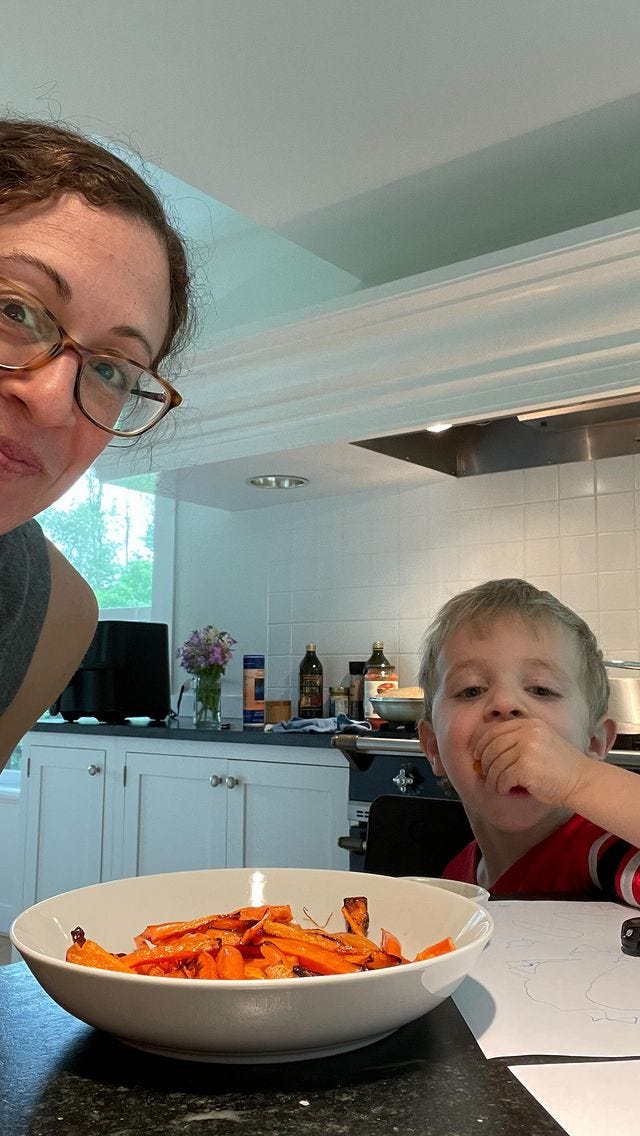
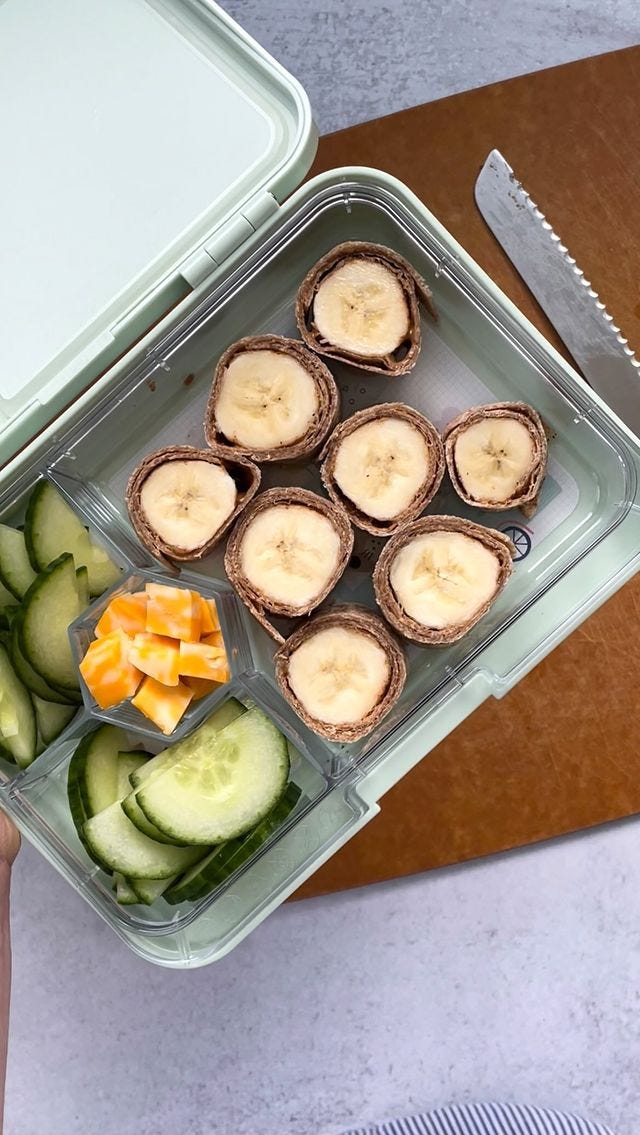
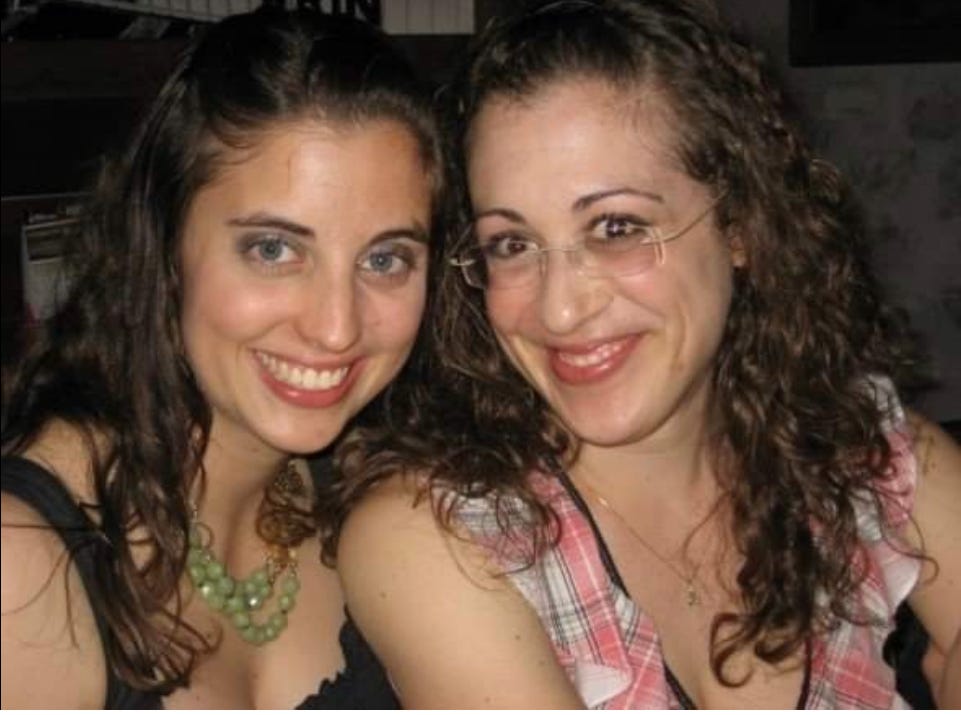





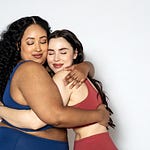
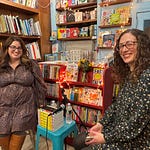
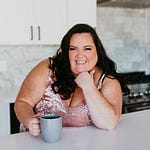
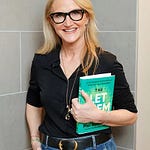
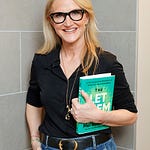
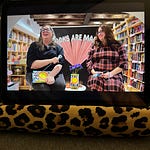
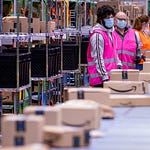

That carrot video is adorable. Apart from the carrot-eating, just the conversation. My kid used to eat cooked vegetables dipped in ketchup but now he pretty much only wants raw ones. Except chicken saag from one specific Indian restaurant. Kid won't touch a leafy green otherwise but he'll eat the whole container of that. Which I guess is similar to the situation with the carrot video: there are maybe things one kid will eat that will make the other parents go "I wish mine would eat like that!" but it might just be one specific thing and for the most part that kid eats like all the other kids.
The banana sushi thing struck a chord, not that mine eats bananas. But he pulls apart regular sandwiches so I just started putting the peanut butter on each slice of bread so when he pulls it apart, he has two equally peanut buttery sides. (He does not like jam for some reason, it's not that I'm keeping it from him. In fact I wish he'd eat it because PB&J is one of the alternate lunches at his school and I think he'd be happier with the extra option.)
This was fascinating! I’ve often wondered how women do everything required to run their online businesses while having a “real life” too. So many expectations on all fronts. I know for sure that I don’t have the drive or thick enough skin! I’m grateful to those of you who do. I learn so much from you.
I also learned so much from this one!
I really enjoyed this episode and hearing Amy’s perspective as a food content creator! As I listened, I was thinking of my own experiences as a recipe developer; I was not paid money for my time, efforts, or produced content. I was “paid” with product. Lots of product! At one point, I had a separate pantry devoted to all the stuff sent to me (for free!) to create recipes and social media/blog posts. I was hoping that Amy would touch on this during your conversation - the need to be paid beyond receiving free products.
So true! Jo Piazza's podcast UNDER THE INFLUENCE talks a lot about the weird income discrepancies in this work. It's absolutely another way that the labor gets devalued unless you're among the very few who have fully monetized it.
I do not work for product and I strongly encourage that no one else does either—no matter where they are in their business. Because the more people say no (because you cannot pay the bills with a free popsicle mold) the more brands will know they can’t ask this.
Thank you for mentioning & encouraging people to not work for product alone. I wish I’d had that advice years ago.
Loved that you got the Comfort Food Band back together! ;)
Great conversation. Thank you!